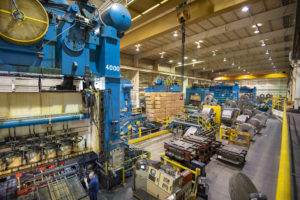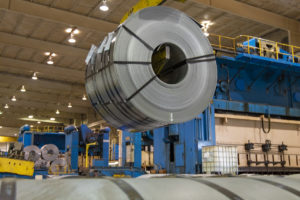Precision Blanking
Precision blanking describes the process in which a metal piece, known as a blank, is punched out of a metal strip or sheet using shearing force. The process involves running a coil through a die to be punched out in a desired shape. A blanking punch, also shaped to match the desired part, is placed above the metal coil. A press is then used to drive the punch down into the die opening, removing the blank from the larger primary metal sheet.
Carbon Steel Precision Blanking
Carbon steel is an alloy of iron and carbon that contains up to 2.5% of carbon by weight. It can be categorized into four groups—low, medium, high, and ultra-high carbon steel—based on the percentage of carbon present. A higher carbon content makes the steel stronger and harder but also reduces ductility and makes it more brittle. Benefits of carbon steel include:
- Strength. The strength and durability of carbon steel make it an ideal choice for use in everything from tool manufacturing to building modern road supports.
- Low cost. Carbon steel tends to be cheaper relative to other metals.
- Environmentally friendly. Carbon steel is easier to recycle than many other metals.
In comparison to stainless steel, carbon steel is stronger and is generally preferred when durability is a factor. Other factors to consider when choosing between stainless and carbon steel include substance and temperature exposure.
For example, carbon is more tolerant of high temperatures than stainless steel. However, if appearance is a factor, stainless steel might be preferred due to its desired sheen and ability to retain a shine even when exposed to weather and other elements. Stainless steel is also less susceptible to rust and corrosion when exposed to moisture than carbon steel.
Aluminum Precision Blanking
Aluminum is the most prevalent metal on earth. The industrial importance of aluminum comes from its unique blend of valuable traits, including durability, reflectivity, ductility, recyclability, and malleability. Other benefits of aluminum include:
- Strength-to-weight ratio. Aluminum is strong, but also lightweight. For this reason, it is commonly used in car parts to enable better fuel efficiency. It is also a vital component in aircraft manufacturing.
- Electrical and thermal conductivity. Like a great conductor of heat and electricity, aluminum is frequently used in power lines and electronic components.
- Corrosion resistance. Aluminum is resistant to corrosion and certain harsh chemicals.
Stainless Steel Precision Blanking
Stainless steel is a steel alloy containing 10-30% chromium by weight. It is known for its aesthetic appeal, making it common in the production of home appliances. Benefits of stainless steel include:
- Strength and durability. Stainless steel is a strong, durable metal that retains its strength even when exposed to temperature and weather extremes.
- Corrosion resistance. The higher the chromium content, the better the corrosion resistance of stainless steel. Stainless steel is a popular material choice for applications in which there may be exposure to alkaline or acid solutions.
- Low maintenance. Stainless steel products are highly functional, yet low maintenance and easy to clean. Stainless steel is commonly used in industrial and commercial kitchens, hospitals, and other spaces where cleanliness and ease-of-maintenance are important factors.
Blanking at Ohio Valley Manufacturing
At Ohio Valley Manufacturing, we offer eight blanking production methods and have the equipment and expertise to handle both small-scale and large-scale production runs. We offer the following specifications for fine blanking:
- Materials. We specialize in working with carbon steel, aluminum, and stainless steel.
- Capabilities. We provide production, contract manufacturing, bulk, plant assist, custom, intricate, and prototype options for blanking.
- Blank sizes. We can produce circular blanks in sizes of up to 72” in diameter and configured blanks in sizes of up to 72” wide and 100” long.
- Part thickness. We are equipped to process materials with thicknesses ranging from 0.020–0.625”.
We have the highly trained staff and cutting-edge equipment necessary to meet the unique needs of customers from a range of industries. To learn more about our capabilities and how we can assist you with your precision blanking needs, contact us today.






